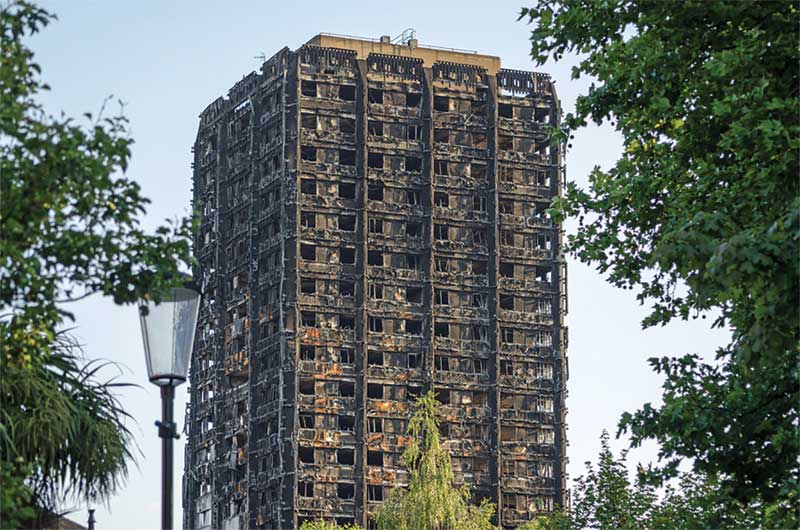
Photo © BigStockPhoto.com
Evolution of curtain wall façade construction
Curtain wall design has become common in commercial construction in the last 40 years. Metal cladding is often used because it is attractive and can be easy to clean. For example, it was installed on the Grenfell Tower, a 24-story, mid-1970s structure in the United Kingdom, to give it a more modern look. Curtain wall systems (i.e. non-structural external cladding spanning multiple floors) are typically supported by clip or girt mounting methods, connecting the framing system at the edge of each floor. This normally results in a gap between the edge of each floor and the curtain wall. It has become more common for building codes to permit non-traditional materials to be employed in larger and higher buildings in order to improve energy performance, reduce water and air infiltration, and allow for aesthetic design flexibility.
These non-traditional systems include:
- exterior insulation finish systems (EIFS);
- metal composite claddings;
- high-pressure laminates; and
- weather-resistive barriers (WRB).
The combustibility of the exterior wall assembly components, in the author’s experience, has been known to directly impact the fire hazard to the building.
Combustible materials employed in exterior walls have played a contributing role in numerous fires worldwide. The aptly named “Torch Tower” high-rise building in Dubai, United Arab Emirates, has seen two major cladding fires in the past four years. The tower first went up in flames in February 2015. More than 1000 people were evacuated from the 337-m (1105-ft) tall, 87-story building. The structure was repaired, but experienced a second cladding fire on August 4, 2017. According to officials at the Dubai Civil Defense Department, electric circuits caused the 2015 fire, and a cigarette carelessly tossed from a balcony and landing on a plant in a lower balcony resulted in a fire in 2017. While there were no reported deaths, Dubai Civil Defense reported 38 apartments were damaged in the fire, and 64 floors were affected by the blaze.
Experts also cite combustible cladding as a factor in similar fires in which flames raced along the sides of buildings, including:
- a high-rise fire in a building under renovation in Shanghai, China, in 2010 that resulted in the death of at least 58 people when it re-entered the building on multiple floors;
- a 2015 apartment fire in Azerbaijan that left 16 people dead; and
- a 2009 fire at TV Cultural Center in Beijing, China, that killed a firefighter.
Similarly in Melbourne, Australia, more than 400 people were evacuated from the Lacrosse Tower on November 25, 2014, when a discarded cigarette on a balcony started a fire that quickly spread up the face of the building. While there were no fatalities, owners of the Lacrosse Tower, at the time of writing, are claiming more than $12 million in damages, and lawyers for the owners are claiming almost $1 million in lost rent, money spent on emergency accommodation during the fire emergency, and compensation for an increase in insurance premiums since the blaze.
During the One Meridian Plaza (Philadelphia) fire in 1991, flames broke through several windows around a major portion of the fire-origin floor, exposing the floor above to auto-exposure from flames lapping up the side of the building. Additional alarms were called to bring personnel and equipment to the scene for a large-scale fire suppression operation. As the fire developed on the 22nd floor, smoke, heat, and toxic gases began moving through the building. Vertical fire extension resulted from unprotected openings in floor and shaft assemblies, severe deflection of the floor assemblies, and the lapping of flames through windows on the outside of the building. (To read more, click here.)
Most recently, the tragic fire in the Grenfell Tower on June 14, 2017, killed at least 80 people, but police said only 21 of those victims could be formally identified. The fire spread rapidly up the exterior of the building, circumventing the interior fire protection features, re-entering from the exterior, and eventually consuming every floor.
What all of these fires have in common is the ability of the fire to spread by one or more of the three mechanisms described earlier, either singly or in combination.




